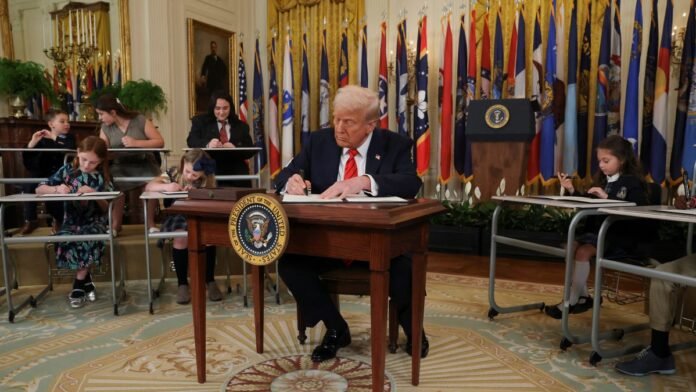Despite the Department of Education’s massive budget, students in the U.S. far too often lag behind peers in other industrialized countries.

State Department layoffs begin, more than 1,350 employees fired
Some laid off employees were seen carrying boxes out of the U.S. State Department as supporters bid them farewell with applause and hugs.
- The federal government is the largest employer in the U.S., and the Trump administration is reducing its size.
- Layoffs have occurred at the State and Education Departments, the latter of which has a $268 billion budget despite declining student test scores.
- USA TODAY columnist Nicole Russell argues that reducing the federal bureaucracy in education will give more control to states and local districts, leading to better choices for parents.
- The author notes that federal job cuts are happening amidst a larger trend of companies restructuring and adapting to technological changes.
The largest employer in the United States isn’t a Fortune 100 company like Alphabet, Amazon or Apple. It’s the federal government − and that’s a problem.
Thankfully, President Donald Trump continues to slash bureaucratic bloat. On July 11, the administration sent layoff notices to more than 1,300 State Department workers, and three days later, the Supreme Court allowed Trump to move forward with plans to gut the Department of Education.
That’s bad news for government employees, but great for taxpayers, especially given the Education Department’s expense − $268 billion in the last fiscal year − and its lack of effectiveness.
Despite the department’s massive budget, students in the U.S. far too often lag behind peers in other industrialized countries. In 2022, for example, American high school students scored behind teens from 25 other countries on an international math test.
And we’re losing ground. Math and reading scores on the National Assessment of Educational Progress continue to decline. Part of the drop can be attributed to pandemic-related learning loss, but reading scores in the U.S. began to decline in 2019 − before Americans had even heard of COVID-19.
But how will pulling the federal government out of K-12 education help? It’s important to note that more than 90% of public school funding comes from state and local governments along with foundations and other private sources.
Much of the federal education budget is used to feed the bureaucracy, which generates rules and regulations that local administrators and teachers must obey. If all of that bureaucratic oversight consistently produced better results, there might be a case for keeping it. But the data clearly shows it doesn’t.
Removing federal bureaucrats from our schools should give states and local school districts more flexibility to set education policy, and that should improve choices for parents like me. Returning more control to the states also should improve efficiency and enable schools to better meet students’ needs.
Government efficiency is vital for the American people
Trump isn’t cutting jobs only at the Education Department, of course. The State Department layoffs follow reductions at other federal agencies this spring.
The cuts are driven by necessity: our national debt is now more than $37 trillion and the annual budget deficit will top $1 trillion again this year.
So, I was surprised to see news reports paint the laid off State Department workers as heroic. Cameras caught teary goodbyes and applause for well-liked employees. I don’t recall the same concern when President Joe Biden halted construction of the Keystone Pipeline, which cost 1,500 workers their jobs and eliminated plans to create thousands more.
Companies often restructure. So should the federal government.
While job loss is certainly scary, and I don’t wish it on anyone, federal job cuts should be put in the context of the overall jobs market.
Microsoft announced this month it would eliminate 9,000 jobs, not because the company is failing but because it’s retooling as the market changes. Other companies, including Intel and Meta, have announced plans to restructure this year as the emergence of artificial intelligence and other technology changes how Americans work.
The federal government should be as flexible as our top companies in adapting to a changing world.
Yet, progressives have criticized the Trump administration’s efforts to restructure the federal bureaucracy as cruel.
The president’s job, however, isn’t to employ as many bureaucrats as possible. It’s to deliver effective services as efficiently as possible to taxpayers. Dismantling ineffective and inefficient bureaucracies like the Education Department is a long overdue step toward achieving that goal.
Nicole Russell is a columnist at USA TODAY and a mother of four who lives in Texas. Contact her at nrussell@gannett.com and follow her on X, formerly Twitter: @russell_nm. Sign up for her weekly newsletter, The Right Track, here.
